Text and images by Pratibha Baveja, PhD Candidate at National University of Singapore, Singapore
Recently, a research team from National University of Singapore (NUS) in collaboration with Syiah Kuala University and Aceh Birder conducted an expedition to investigate the avifauna on the ornithologically lesser explored islands of West Sumatra (see map below). One of the major goals of this expedition was to document the current status of Barusan Shama Copsychus (malabaricus) melanurus on these islands. Barusan Shama is one of the most heavily traded and highly priced birds in the Indonesian bird markets. It is distinguished from the more widespread White-rumped Shama Copsychus malabaricus as it has a complete black tail, darker red underparts and less pronounced sexual dimorphism. However, as Barusan Shama is not recognized as a distinct species by BirdLife International, there is no concrete conservation or legal protection status for this unique taxon. Consequently, these birds have been the subject of frequent hunting and their numbers, over the years, have dwindled to precariously low levels, bordering on near extinction.
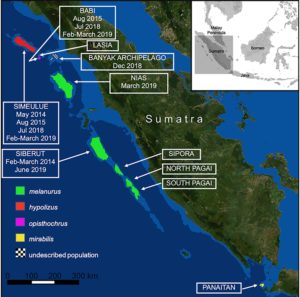
According to taxonomy of Eaton et al. 2016, Barusan Shama is recognized as a distinct species with four subspecies: melanurus from Nias and presumably Mentawai, hypolizus from Simeulue, opisthochrus from Babi and Lasia and mirabilis from Panaitan. Between 2014-2019, our team visited the West Sumatran Archipelago to assess the current ground status of the species and collect sample for genomic analyses to discern the taxonomy of the White-rumped Shama complex. During these visits, we used visual, acoustic and mist-netting surveys supplemented with local ornithological observation, through community interviews to get a holistic picture of the bird status on these islands over the years.
Current status on West Sumatran islands
Simeulue: During the 4 visits to the northernmost deep-sea island of West Sumatran chain, Simeulue, we did not encounter any Barusan Shama in the wild visually or otherwise. Our interaction with locals who were familiar with the bird that is locally known as murai batu agreed that the bird is extinct in the wild or extremely rare. During previous visits to the island, we had formed a trustworthy association with one of the main Shama breeder in Sinabang, the capital of Simeulue, who informed us that the local capture rate had declined steeply from 1-2 individuals per week in 2014, to 1 individual per month in 2015. We managed to visit the breeding facility in Sinabang and collect blood samples for different island individuals through the breeder in 2019. The breeder was very cautious with the shamas and allowed us to take samples after we assured him that the process would not aesthetically damage the bird’s appearance or make it weak. We were hardly given 1-2 minutes to collect sample with each individual. The extreme caution shown by the breeder is not surprising as the market price of the bird can be as high as 5 juta Indonesian rupiah (~US$ 370) and any harm would translate into a great financial loss for him. Through these interactions with locals and our surveys on the island of Simeulue where all the surviving forests are close to human habitation, we are convinced that hypolizus is extinct in the wild and only a few individuals survive in captivity (~100 individuals).

Babi & Lasia: Babi and Lasia are officially uninhabited, deep sea paleo-islands south of Simeulue and reaching these islands involves a 5-6 hours boat journey from Simeulue, often marred with inclement weather. Due to the physical hardships of reaching these islands, one would assume that it would have a few surviving shamas, yet the situation was opposite.
During our 3 visits to Babi between 2015-2019, we surveyed approximately 2 km into the interior of primary forests of Babi trying different forest trails but did not encounter any shamas in the wild. Babi has a single antenna tower. The warden managing the tower recounted how the shamas fell prey to hunting and poaching activities. The Javanese trappers had visited the islands around 2010, catching thousands of shamas and the local trappers followed suit. The warden’s anecdote aligned with our observation of many fisherman boats on both Babi and neighboring Lasia.
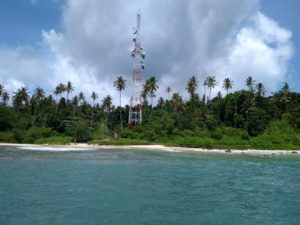
As these are small islands, opisthochrus is most likely extinct in the wild, while a few individuals might still be found in captivity.
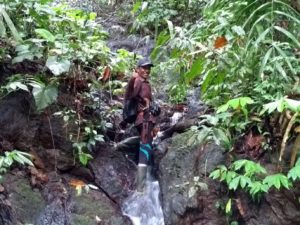
Bankaru & Tuangku: Bangkaru and Tuangku are shelf island members of the Banyak archipelago, south of Simeulue and north of Nias, harboring an undescribed population of shamas. Bangkaru has a lot of primary rainforests and is uninhabited except for a few forest rangers employed for turtle conservation. We stayed at the rangers’ station and were assisted by the rangers in our extensive forest trails on this island in 2018. With the guidance of the most experienced ranger to the known habitats of shama, we traversed through the different microhabitats on Bangkaru, climbed the waterfall to reach the highest hill and ultimately landed on the other end of the island with no visual or acoustic encounter of Barusan Shama despite using playback devices. The mist netting surveys also did not yield any shama. On the highest hill of Bangkaru, we noticed traces of plastic within the core forests, indicating recent human presence. According to the forest rangers, poachers were relatively less frequent to Bangkaru compared to Tuangku due to the presence of the rangers, however, we noticed fisherman boats anchored on the eastern coast of Bangkaru facing Tuangku. The most experienced ranger told us that his own personal encounter with a shama was a year back. As Bangkaru is a small island, there is little chance of survival of shama on this island.
From Bangkaru, we traveled to Tuangku via a 2-hour boat journey. The island had a number of villages and we witnessed ongoing large scale forest conversion in Tuangku. Through our surveys and local interactions, we found that the shamas have been extinct on the island, conforming with the Bangkaru rangers’ knowledge of the high poaching pressure in Tuangku.
We encountered a single Bangkaru individual with the local breeder in Singkil, a town adjacent to the Banyak islands in mainland Sumatra. The morphology of the individual suggested that the Bangkaru population could be intermediate between White-rumped Shama from Sumatra and Barusan Shama of West Sumatran islands. Further genomic analyses would confirm the identity of this population.
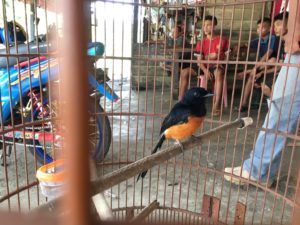
Nias: Nias, one of the largest West Sumatran islands, is the most degraded island having a few remaining patches of secondary forests. Almost all the forests have been converted to villages or rubber plantations and we did not find any shamas in the wild during our surveys as expected. In the capital Gunungsitoli and region surrounding the capital, we saw a large number of caged Barusan Shama displayed by the roadside vendors that were caught a few years back. Nias faces a high poaching pressure and based on our interaction with locals and our field surveys, it is highly likely that melanurus is extinct in the wild on this island.
Mentawai: As Siberut from the Mentawai archipelago is still covered with primary forests, it was thought to be the last refuge of Barusan Shama in the wild. In 2019, we visited Siberut with the hope of finding a comparatively less threatened and large population of Barusan Shama. Our first day on the island was enough to wipe out all our illusions. Siberut was an island undergoing a rapid transformation, both in terms of habitat and human culture. While the large-scale deforestation to construct the Trans-Siberut Highway would ensure habitat loss, the approach of religious missionaries would ensure that the ensuing established villages inhabited by tribal population would have a religion.
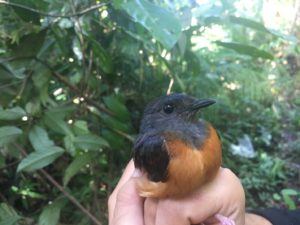
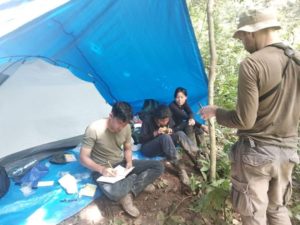
Based on local advice, we began a two-day hike to the hill forests of West Siberut that were yet not ‘developed’ to increase our chance of encountering the wild shamas. All our porters were extremely familiar with the shama, few of the younger ones even possessed shama calls in their mobile devices. During our hike through the recently established villages, we observed evidence of local trapping of birds; we saw small cages cramped with different species of birds including Olive-winged Bulbul and Orange-bellied Flowerpecker demonstrating that the trappers were not species-specific. Also, we observed traditional bows and arrows hung to the wall and men carrying air rifles. Through most of the hike in the forest near the villages, we were accompanied by the mechanical sound of chainsaws. We set up our camp at a high elevation within dense primary forest and carried out mist netting, visual and acoustic surveys for the next 3 days. A detailed video interview with one of the porters explained how only 1-2 years ago, Palembang traders had arrived and taught the locals to trap shamas, buying thousands of shams at a low price and selling them at a higher price later, ultimately wiping most of the shama population in Siberut. We mist netted a single juvenile Barusan Shama in this area, giving us hope that a small population of wild shama still survives in this remote location of Siberut. Even though we did not share that we had mist netted a shama with the local porters, we noticed that during the brief period when we heard the shama before mist netting it, one of the porters who had formerly been a trapper himself became extremely attentive. A new wave of poaching activity could endanger the survival of the small population of shamas in Siberut.
Panaitan: In Panaitan, Barusan Shama was last reported in 1980s. We did not visit this island but most likely it is extinct here due to its proximity to the Javan bird markets.
Way forward
Our assessment of West Sumatran islands suggested that melanurus from Nias and presumably Mentawai survives commonly in captivity. A few individuals (~100) of hypolizus from Simeulue and a handful of opisthochrus from Babi and Lasia might also survive in captivity. Unfortunately, mirabilis from Panaitan is already extinct.
We rarely met anyone who was unfamiliar with murai batu, such is the popularity of Barusan Shama in the wildlife trade. In fact, we met people who are trained in elaborate methods of bird-hunting involving gums, decoys and torchlights. Undeniably, hunting is so widespread that it seemed like we were always a step behind the poachers in reaching the islands. The current dire status of Barusan Shama on West Sumatran islands suggests that the only way to save this unique taxon from extinction is through immediate efforts of ex-situ conservation breeding. In late 2019, few stakeholders including Wildlife Reserves Singapore (WRS), Ecosystem Impact Foundation (EIF) and members of the IUCN Asian Songbird Trade Specialist Group (ASTSG) have already come forward to begin implementation of conservation breeding facilities. The genomic analyses of shamas, currently underway in National University of Singapore, would guide these concerted efforts. These efforts should be complemented with human behavioral interventions that would ensure long term survival of the species.
With an integrated conservation action plan, we hope that the Barusan Shama will continue to sing in the forests of the West Sumatran islands where their songs are not judged for prestige or money, but embraced as a part of the nature and its beauty.
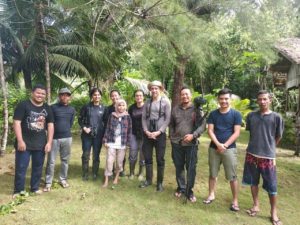
Note: The results of this expedition have been published and can be found together with many other interesting publications on the website of the NUS Avian Evolution Lab
VIDEO interview with Mr. Bowo from Siberut
